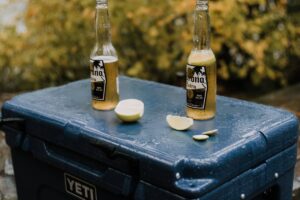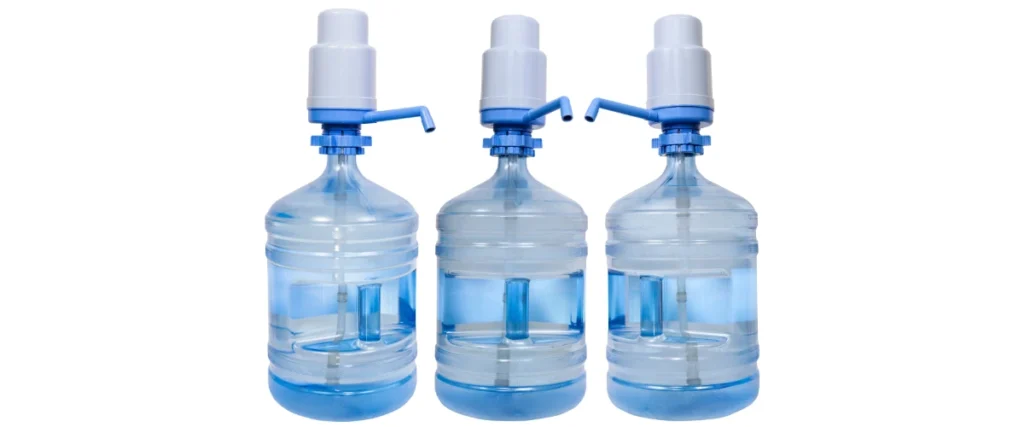5-Gallon Water Bottles for Camping and Overlanding
For as long as I can remember, I’ve been using 7-gallon blue water Reliance Aqua-Tainer for my truck camping trips and overland adventures. But the work required in cleaning and sanitizing them has always been a pain in the butt.
This year, I switched that up. We have a water dispenser in our house for both cold and hot water and a last-minute camping trip came up. In a hurry, I grabbed two 5-gallon water bottles and hit the road. Best of all, they are recyclable and replaceable along a road trip at local grocery stores and frees you from the chore of cleaning, sanitizing, drying, storage and everything else that is annoying about them.

In addition, these fit perfectly in my pickup bed underneath my tonneau cover and easily strapped to my rack system with cargo straps.
One note on recycling, I haven’t had any issues swapping bottles at grocery stores or with my home water service taking them on my monthly delivery. But in double-checking the recyclability of these, I did see a few people having issues having stores take them. Most likely as a Covid-era precaution. Just throwing this out there for transparency.

Why Use 5-Gallon Water Bottles for Camping and Overlanding?
Choosing a reliable water source is vital when heading off the beaten path. Here’s why 5-gallon water bottles make an excellent choice:
- High Capacity for Longer Trips: One 5-gallon container is typically sufficient for one or two people for a few days of drinking, cooking, and light washing.
- Durability: The heavy-duty plastic construction is designed to withstand rough handling and can easily be transported over bumpy trails without damage.
- Space Efficiency: While large, 5-gallon bottles are more compact than multiple single-use bottles, saving valuable space in your vehicle for other gear.
- Readily Available: 5-gallon water bottles are readily available at local grocery stores and homegoods stores.
- Recyclable: 5-gallon water bottles are recyclable at the place of purchase.
Planning Water Needs for Your Trip
Estimating water requirements is essential for any adventure. While one gallon per person per day is a general recommendation, factors like climate, physical activity, and cooking needs may increase this amount. For a multi-day trip, plan on having enough water for both hydration and basic hygiene.
For instance:
- A weekend trip for two may require one or two 5-gallon bottles for drinking, with additional water for cooking and cleaning.
- For longer expeditions, consider supplementing with water purification tools or extra containers to refill as needed. Or schedule resupply stops along your route.
Tips for Storing and Transporting 5-Gallon Bottles
To keep your water fresh and accessible throughout your trip, follow these storage tips:
- Cool, Shaded Storage: Avoid direct sunlight in your vehicle, as UV rays can promote algae growth. Storing bottles in a cool, shaded area (like a covered bed or cargo area) will help keep your water fresh.
- Secure the Bottles: Use bungee cords or tie-downs to prevent bottles from shifting or tipping during travel. Placing them on a non-slip surface can also help.
- Elevate from the Ground: For campsite storage, keeping bottles slightly off the ground helps prevent dirt and moisture from contacting the bottle’s base and minimizes contamination risks.
- Storing at Home: If you are storing filled bottles at home for future use, make sure you store them on a wood pallet or shelving unit to reduce the risk of contamination from moisture on concrete floors, especially in areas with high humidity.
Accessing Water on the Road
When you’re in remote areas without a standard water dispenser, there are several ways to access your water easily:
- Manual Water Pumps: A manual pump is an excellent addition for overlanding. These small, portable pumps fit snugly onto the bottle opening, allowing you to pump water directly without needing to tip the heavy bottle. I’ve been using this HotFrost Manual Pump from Amazon
- Portable Spigot Attachments: Some 5-gallon water bottles come with spigot attachments, which turn the bottle into a convenient “faucet.” This is a great option for dispensing water at the campsite or for cooking.
- Gravity-Flow System: If you have access to elevated surfaces, place the bottle on a higher platform and use a spigot attachment to create a simple gravity-fed system, making it easy to fill containers below.
- Careful Pouring: When no attachments are available, tip the bottle slowly to pour water into another container. Placing it on its side and scooping with a cup can be an effective way to control the flow.
Water Conservation Tips for Remote Adventures
Out in the wilderness, every drop counts. These strategies can help you stretch your water supply:
- Use Biodegradable Wipes: Substitute wipes for washing when possible, reducing your need for water on hygiene tasks.
- Reuse Cooking Water: Repurpose leftover boiling water for cleaning dishes or rinsing utensils to minimize waste.
- Practice Efficient Hygiene: Instead of full showers, use small quantities of water with a cloth for quick cleaning.
My New Camping Companion
A 5-gallon water bottle is a practical, space-saving solution for keeping water accessible on your adventures. By following these best practices, you’ll have a reliable source of fresh water to support hydration, cooking, and hygiene, making your camping or overlanding experience both safe and enjoyable.